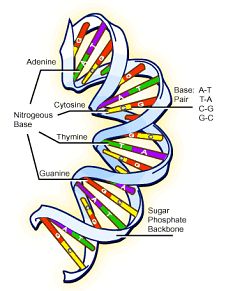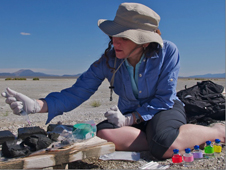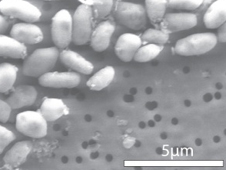A NASA researcher has discovered a bacterium that can live without phosphorous, substituting arsenic instead.
Background:Scientists have believed until now that life requires six elements:
carbon, hydrogen, oxygen, nitrogen, sulfur, and phosphorous. In fact,
the DNA of known life forms is made of nucleic acids made of Carbon,
Hydrogen, Oxygen, Nitrogen and Phosphorous. The double helix structure
formed by the four amino acid groups, adenine, guanine, cytosine and
thyamine, is bound by phosphorous cross-links. It acts as a back-bone or
spine that holds together the double helix providing stability. The
argument — until yesterday — would have been that without phosphorous,
you cannot have DNA; without DNA, you cannot have life. NASA astrobiologist Felisa Wolfe-Simon announced that such statement
should probably have to be rewritten.
| | 
Figure: The DNA double helix
|
The new study:
At a NASA press conference at 1:00 pm, December 2, 2010, Dr. Wolfe-Simon
described work by her team to identify organisms that could make
interesting elemental substitutions in biomolecules. Specifically the
team looked at Mono Lake, located in California, USA in the Eastern
Sierra. Mono Lake is representative of an extreme environment because it
registers a pH of 10, is three times more salty than sea water, and
contains arsenic in great concentration (average = 200µM), an element
forming toxic species such as arsenate and arsenite. (We reported about
that place before !)
| | 
Photo: Mono Lake Research area
|
| Dr. Wolfe-Simon and colleagues were specifically looking for organisms
that would substitute arsenic for phosphorus in biological
macromolecules like DNA, lipids and proteins. They chose arsenic because
it shares many physical characteristics with phosphorus, although it
does contain additional electrons within lower energy orbitals that make
it more reactive than phosphorus. They took a sample of the lake sediment and selected for organisms that
could survive on arsenic by culturing in an artificial alkaline medium
(pH 9.8) with glucose, vitamins, trace metals but no added phosphate nor
any yeast extract or peptone, and 100µM arsenate that was gradually
enriched to 5mM (1). | | 
Photo: Felisa Wolfe-Simon processing mud from Mono Lake to inoculate media to grow microbes on arsenic.
Image Credit: Henry Bortman
|
The resulting culture was diluted and plated on
artificial growth medium with 5mM AsO43–. The isolated colony was
reinoculated into the liquid artificial medium and the optimal amount of
arsenate for growth was assessed. This isolate, named GFAJ-1, is
maintained on 40mM AsO43–, 10mM glucose and no phosphate and was
identified as a member of the Gram negative Halomonadaceae using 16S
rRNA sequences. So this newly dubbed isolate of interest can be grown with only arsenate
in its medium. However, GFAJ-1 could also grow in artificial medium
with phosphate, no arsenate.
| | 
Photo: mage of GFAJ-1 grown on arsenic.
Image Credit: Jodi Switzer Blum |
The primary physical difference between
GFAJ-1 grown with arsenate versus with phosphate is the size of the
organism; it is 1.5 times larger when cultured with arsenate and is
likely due to the increase vacuole size seen under the microscope.
Is this bacterium really using arsenate like it normally uses phosphate? Phosphate is elemental to life for a reason—our proteins, lipids and nucleic acids are built with and use phosphate. The amount of intracellular phosphorus in the cells grown in arsenate medium was measured at 30-fold lower than the same organism in phosphate medium. This deficit indicated that the cells were substituting arsenate for phosphate. The intracellular arsenic in GFAJ-1 grown on arsenate varied, and the authors suggested the postulated instability of the cellular structures using arsenic might be the culprit.
The intracellular distribution of arsenate was examined using radioactive
73AsO
43– and observing the radioactivity in each cellular fraction. The majority was found in the protein fraction with the caveat that the numerous nonprotein metabolites like ATP and NADH likely overestimate the quantity. However, arsenic was also found in the nucleic acid, lipid and metabolite fractions. The researchers decided to focus on the nucleic acids, specifically the genomic DNA, to further examine the arsenic substitution for phosphorus. Phosphate is an integral part of the backbone of the DNA helix , and so this is where arsenate would be expected in the genomic DNA.
Genomic DNA from both arsenate- and phosphate-grown GFAJ-1 was gel purified and the ratio between As:P determined. The analysis found that when the cells were grown in arsenate, arsenic was found in greater amounts than phosphorus and vice versa for phosphate-grown GFAJ-1. Analysis with laser-like X-rays from a synchrotron particle accelerator indicated that this arsenic took the form of arsenate, and made bonds with carbon and oxygen in much the same way as phosphate.
GFAJ-1 is a unique organism because while it is part of the Halomonadaceae family of Gammaproteobacteria, which have been known accumulate arsenic (2), this is the first living organism to substitute the use of one element, As, for another, P.
"The idea of alternative biochemistries for life is common in science fiction," said Carl Pilcher, director of the NASA Astrobiology Institute at the agency's Ames Research Center in Moffett Field, Calif. "Until now a life form using arsenic as a building block was only theoretical, but now we know such life exists in Mono Lake."
Meanwhile, Wolfe-Simon and her colleagues agree that there is a lot more to be done. The first step is to see whether these or other bacteria replace phosphate with arsenic naturally, without being forced to do so in the lab, she says. The group also has plans to sequence the microbe's genome.
The analysis performed only suggest its use in biomolecules, but at the NASA news conference, Dr. Wolfe-Simon stated that she and her team have been delving further into the mysteries of this organism and will be submitting another paper February 2011. We will report about it.
 References
References
[1] F. Wolfe-Simon, J. Blum, T. Kulp, G. Gordon, S. Hoeft, J. Pett-Ridge, J. Stolz, S. Webb, P. Weber, P. Davies, A. Anbar, R. Oremland,
Retracted: A Bacterium That Can Grow by Using Arsenic Instead of Phosphorus, Science, 332 (2011) 1163-1166.
DOI: 10.1126/science.1197258
[2] M. Takeuchi, H. Kawahata, L.P. Gupta, N. Kita, Y. Morishita, Y. Ono, T. Komai,
Arsenic resistance and removal by marine and non-marine bacteria. J. Biotechnol., 127 (2007) 434–42.
doi: 10.1016/j.jbiotec.2006.07.018 Related studies:
Related studies:
T. R. Kulp, S.E. Hoeft, M. Asao, M.T. Madigan, J.T. Hollibaugh, J.C. Fisher, J.F. Stolz, C.W. Culbertson, L.G. Miller, R.S. Oremland,
Arsenic(III) Fuels Anoxygenic Photosynthesis in Hot Spring Biofilms from Mono Lake, California, Science, 321/5891 (2008) 967-970.
DOI: 10.1126/science.1160799
Felisa Wolfe-Simon, Paul C.W. Davies, Ariel D. Anbar,
Did nature also choose arsenic?, International Journal of Astrobiology, 8 (2009) 69-74.
doi: 10.1017/S1473550408004394
Mostafa I. Fekry, Peter A. Tipton, Kent S. Gates,
Kinetic Consequences of Replacing the Internucleotide Phosphorus Atoms in DNA with Arsenic, ACS Chem. Biol., 6/2 (2011) 127-130.
DOI: 10.1021/cb2000023 Related Resources
Related Resources Mono Lake Chemistry
Mono Lake Chemistry NASA Planetary Biology Internship Program (PBI)
NASA Planetary Biology Internship Program (PBI) USGS Arsenic studies group
USGS Arsenic studies group Wikipedia: Halomonadaceae
Wikipedia: Halomonadaceae Related News
Related News (newest first)
 National Geographic, December 2, 2010: Mono Lake bacteria build their DNA using arsenic
National Geographic, December 2, 2010: Mono Lake bacteria build their DNA using arsenic EVISA News, October 14, 2010: Scientists solve mystery of the two sides of arsenite
EVISA News, October 14, 2010: Scientists solve mystery of the two sides of arsenite EVISA News, March 17, 2009: Researchers Find Alga that Influence Arsenic Cycling in Hot Springs
EVISA News, March 17, 2009: Researchers Find Alga that Influence Arsenic Cycling in Hot Springs EVISA News, August 16, 2008: Arsenic-eating bacteria rewrite evolutionary history
EVISA News, August 16, 2008: Arsenic-eating bacteria rewrite evolutionary history EVISA News, June 18, 2006: Bacteria supposed to remove poisonous arsenic from drinking water
EVISA News, June 18, 2006: Bacteria supposed to remove poisonous arsenic from drinking water  EVISA News, June 16, 2005: Arsenic concentration in groundwater may be affected by bacteria
EVISA News, June 16, 2005: Arsenic concentration in groundwater may be affected by bacteria last time modified: July 25, 2025